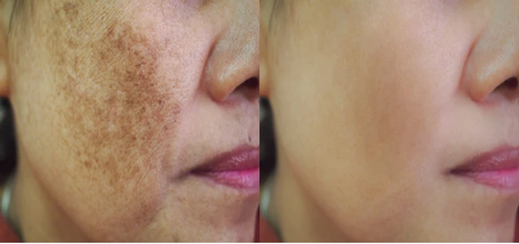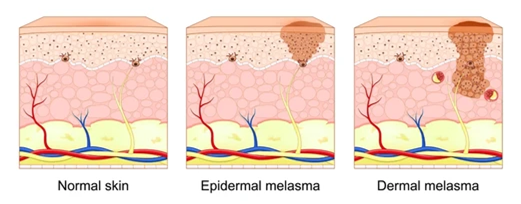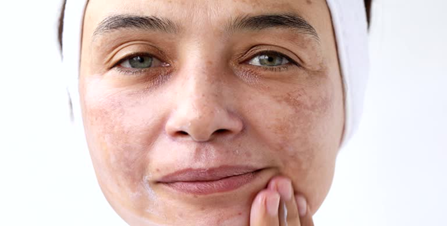Understanding Botox: What is it?
 Melasma is a skin condition characterized by dark patches, which can cause distress for many individuals. The appearance of brown or bluish patches on the face leads to the common question: “Is melasma permanent?” The answer to this question depends on various factors, including the severity of the condition and how it is managed.
Melasma is a skin condition characterized by dark patches, which can cause distress for many individuals. The appearance of brown or bluish patches on the face leads to the common question: “Is melasma permanent?” The answer to this question depends on various factors, including the severity of the condition and how it is managed.
According to Dr. Swetha P, an esteemed dermatologist in Indiranagar, Bangalore, “While melasma can be challenging to treat, it is not always permanent. With the right approach, the appearance of melasma can be significantly reduced, and in some cases, it can even be resolved entirely.”
At Dr. Swetha’s Cosmoderm Centre, a state-of-the-art skin clinic in Indiranagar, Bangalore, Dr. Swetha P provides personalized care for patients with melasma. She offers a range of advanced treatments tailored to each individual’s skin type and condition. Her expertise ensures every patient receives the most effective treatment plan designed to improve their skin’s appearance.
Don’t let melasma affect your confidence. Consult an expert for customized, effective treatment options. Book an appointment now!
What is Melasma?
Melasma is a common skin condition that causes dark, discoloured patches, typically symmetrical, primarily on the face. It is more prevalent in women, especially during pregnancy, but men can also develop melasma.

There are three main types of melasma:
- Epidermal Melasma: This type occurs in the outermost layer of the skin, the epidermis. It is characterized by well-defined, dark brown patches.
- Dermal Melasma: This type affects the deeper layers of the skin, the dermis. The patches are usually light brown or bluish, with less defined borders.
- Mixed Melasma: This is the most common type and involves both the epidermal and dermal layers of the skin. The patches are a mix of dark brown, light brown, and bluish hues.
Understanding the type of melasma is crucial in determining the appropriate treatment approach. Treatments vary in effectiveness depending on the type of melasma.
Is Melasma Permanent?

The permanence of melasma depends on several factors, including the severity of the condition, the type of melasma, the underlying causes, and the treatments applied. In some cases, melasma can be temporary, fading away on its own or with the help of topical treatments. However, for others, it can be more persistent and challenging to manage.
Factors such as hormonal changes, sun exposure, and certain medications can influence the longevity of melasma. For instance, melasma triggered by pregnancy (often referred to as “pregnancy mask”) may gradually fade after childbirth. However, if the condition is not managed properly, it can become a long-term issue.
Treatment options like topical creams, chemical peels, and laser therapy can help reduce the appearance of melasma. Lifestyle changes, such as consistent sun protection and avoiding known triggers, also play a significant role in managing and potentially reversing the condition. Dr. Swetha P states, “Consistency in treatment and lifestyle adjustments are essential in the long-term management of melasma.”
What is the Main Cause of Melasma?
Melasma is primarily caused by an overproduction of melanin, the pigment responsible for the color of your skin. This overproduction can be triggered by several factors, with sun exposure being one of the most significant. Ultraviolet (UV) rays from the sun stimulate melanocytes (the cells that produce melanin) to produce more pigment, leading to the characteristic patches seen in melasma.
Hormonal changes are another major cause of melasma. This is particularly evident in women who are pregnant, taking birth control pills, or people undergoing hormone replacement therapy. These hormonal shifts can increase melanin production, exacerbating the condition.
Other contributing factors include genetic predisposition, certain medications, and even stress. Understanding the root cause of melasma is essential in determining the most effective treatment approach.
Identify the cause of your melasma. Consult a professional for a personalized treatment plan. Schedule an appointment today!
What Areas are Affected by Melasma?

- Forehead: Dark patches may appear on the central forehead, extending towards the eyebrows, due to frequent sun exposure.
- Upper Lip: A “moustache-like” shadow may develop above the upper lip, creating a distinct appearance.
- Nose: Patches can also form on the nose, usually in conjunction with those on the cheeks and forehead.
- Chin: The chin may develop smaller patches, though it is less commonly affected.
- Jawline: The lower face and jawline may also be prone to melasma, particularly in individuals with hormonal imbalances.
- Neck and Forearms: Occasionally, melasma can appear on the neck and forearms, especially in those with darker skin tones and frequent sun exposure.
Melasma typically affects sun-exposed areas, emphasizing the importance of daily sun protection. If dark patches appear in these areas, consulting a specialist can help manage and reduce melasma.
What is the Best Treatment for Melasma?
When it comes to treating melasma, several options are available, each tailored to the severity and type of melasma. Here are some of the most effective treatments:
- Topical Treatments:
Creams containing ingredients like hydroquinone, tretinoin, corticosteroids, or combination creams can help lighten melasma. These are often the first line of treatment.
These involve applying a chemical solution to the skin, which helps to exfoliate the outer layers and reduce pigmentation. Commonly used acids include glycolic acid and salicylic acid.
- Laser Therapy:
Laser treatments, such as fractional lasers and intense pulsed light (IPL), target pigmentation and help even skin tone. They can be effective but may require multiple sessions.
This procedure involves exfoliating the outer layer of skin to improve texture and reduce pigmentation. It is often used in conjunction with other treatments.
- Oral Medications:
In some cases, oral medications may be prescribed to address melasma, particularly when topical treatments are insufficient.
- Hormonal Treatments:
For melasma linked to hormonal changes, such as during pregnancy or with oral contraceptive use, managing hormone levels may help alleviate symptoms.
Visit a seasoned dermatologist today to get the most suitable treatment plan based on the severity and type of melasma. Book consultation now!
Preventing Melasma from Coming Back

Preventing the recurrence of melasma requires a proactive approach. Here are some key strategies:
- Daily Sunscreen Use:
Apply a broad-spectrum sunscreen with SPF 30 or higher every day, even on cloudy days, to protect against UV rays that can trigger melasma.
- Sun Protection Measures:
Wear hats and sunglasses and seek shade to minimize direct sun exposure, especially during peak hours.
- Avoid Tanning Beds:
Avoid using tanning beds, as they can exacerbate melasma and increase pigmentation.
- Consistent Skincare Routine:
Use gentle, non-irritating skincare products to avoid aggravating sensitive skin.
- Regular Dermatological Check-ups:
Schedule regular appointments with a dermatologist to monitor skin condition and adjust treatments as needed.
- Manage Hormonal Fluctuations:
If melasma is related to hormonal changes, work with a medical expert to manage hormone levels effectively.
- Avoid Certain Medications:
Some medications can trigger or worsen melasma. Consult your doctor before starting any new medication.
- Healthy Lifestyle:
Maintain a balanced diet and stay hydrated to support overall skin health and resilience.
Conclusion
Melasma is a common but challenging skin concern that can persist if not managed effectively. By understanding the causes, treatment options, and prevention measures, patients can take proactive steps to manage their condition. At Dr. Swetha’s Cosmoderm Centre, patients receive advanced treatments based on their unique needs, helping them achieve clearer, healthier skin. Dr. Swetha P’s extensive expertise in treating melasma ensures patients achieve the best possible outcomes.
Take the first step towards flawless skin. Consult a specialist for a customized treatment plan. Book your appointment today.
FAQs
Is melasma curable?
In certain instances, melasma may not be completely curable, but it can be effectively managed. Appropriate treatments, such as topical medications, chemical peels, and laser therapy, can significantly reduce its appearance. Consistent sun protection and addressing underlying triggers can help maintain results and prevent recurrence.
Is melasma and pigmentation the same?
Melasma is a type of hyperpigmentation, but not all pigmentation issues are melasma. Melasma typically appears as brown or bluish patches on the skin, often due to sun exposure or hormonal changes.
What is pregnancy melasma?
Pregnancy melasma, also known as the “pregnancy mask,” is a type of melasma caused by hormonal changes during pregnancy. It usually affects the face.
What is the cause of melasma on the face?
Melasma on the face is often caused by sun exposure, hormonal changes, and sometimes by using certain cosmetics or medications.
Which face wash is best for melasma?
A gentle, non-comedogenic face wash with glycolic or salicylic acid ingredients can help manage melasma.
Is melasma the same as pigmentation?
Melasma is a type of pigmentation disorder characterized by dark patches on the skin, whereas pigmentation refers to any discolouration or darkening of the skin.
Reference links:
https://my.clevelandclinic.org/health/diseases/21454-melasma
https://www.healthline.com/health/melasma
Disclaimer: This page is not designed to promote or market any specific treatment or clinic but to offer general insights into melasma management
Disclaimer: The information shared in this content is for educational purposes only and not for promotional use.


